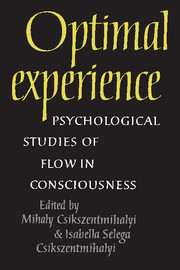Book contents
- Frontmatter
- Contents
- Acknowledgments
- Contributors
- I A THEORETICAL MODEL OF OPTIMAL EXPERIENCE
- II VARIETIES OF THE FLOW EXPERIENCE
- 5 Introduction to Part II
- 6 Bosozoku: flow in Japanese motorcycle gangs
- 7 Women, work, and flow
- 8 The relationship between life satisfaction and flow in elderly Korean immigrants
- 9 Flow and writing
- 10 Flow in solitary ordeals
- III FLOW AS A WAY OF LIFE
- IV THE MEASUREMENT OF FLOW IN EVERYDAY LIFE
- References
- Name index
- Subject index
7 - Women, work, and flow
Published online by Cambridge University Press: 05 June 2012
- Frontmatter
- Contents
- Acknowledgments
- Contributors
- I A THEORETICAL MODEL OF OPTIMAL EXPERIENCE
- II VARIETIES OF THE FLOW EXPERIENCE
- 5 Introduction to Part II
- 6 Bosozoku: flow in Japanese motorcycle gangs
- 7 Women, work, and flow
- 8 The relationship between life satisfaction and flow in elderly Korean immigrants
- 9 Flow and writing
- 10 Flow in solitary ordeals
- III FLOW AS A WAY OF LIFE
- IV THE MEASUREMENT OF FLOW IN EVERYDAY LIFE
- References
- Name index
- Subject index
Summary
Paid work outside the home is becoming the norm for the majority of women in America. Men have traditionally devoted most of their energies to work and have derived from it the main support for their personal identities. How do women experience work? Are they also able to find productive activities in the workplace meaningful and rewarding, or does socialization into the feminine homemaker role prevent women from deriving the same kind of satisfaction from work that men occasionally get from their jobs?
Despite the extensive research on the relationship between work and general quality of life (Spreitzer & Snyder 1974; Pryor & Reeves 1982), on job satisfaction (Wilensky 1960; Dubin, Champoux, & Porter 1975), and on leisure satisfaction (Kando & Summers 1971; Noe 1971; Neulinger & Raps 1972; Bacon 1975; Kabanoff 1980), few studies have incorporated working women in their sample. (For recent notable exceptions see Berk & Berk 1979; and Walshok 1979.) This neglect is particularly unfortunate in that 52.2% of all women and 54% of married women with young children now work outside the home. Participation in the labor force is increasingly required for economic survival (Hesse 1979; Walshok 1979; Mansfield 1982). Of all working women, 77% are now single, divorced, or are married to men with incomes under $15,000 (Mansfield 1982). As these findings suggest, then, women now represent a major sector of the labor force.
- Type
- Chapter
- Information
- Optimal ExperiencePsychological Studies of Flow in Consciousness, pp. 118 - 137Publisher: Cambridge University PressPrint publication year: 1988
- 26
- Cited by



